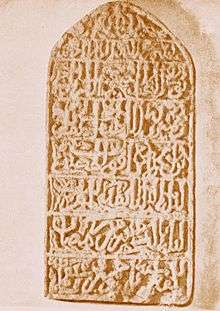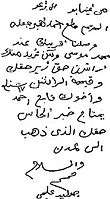Wadaad writing

Wadaad writing, also known as wadaad Arabic, is the traditional Somali adaptation of written Arabic,[1] as well as the Arabic script as historically used to transcribe the Somali language.[2] Originally, it referred to an ungrammatical Arabic featuring some words in Somali, with the proportion of Somali vocabulary terms varying depending on the context.[3] Alongside standard Arabic, wadaad writing was used by Somali religious men (wadaado) to record xeer (customary law) petitions and to write qasidas.[1][4] It was also used by merchants for business and letter writing.[4] Over the years, various Somali scholars improved and altered the use of the Arabic script for conveying Somali. This culminated in the 1950s with the Galal alphabet, which substantially modified letter values and introduced new letters for vowels.[2]
History

The Arabic script was introduced to Somalia in the 13th century by Sheikh Yusuf bin Ahmad al-Kawneyn (colloquially referred to as Aw Barkhadle or the "Blessed Father"[5]),[6] a man described as "the most outstanding saint in northern Somalia."[7] Of Somali descent, he sought to advance the teaching of the Qur'an.[6] Al-Kawneyn devised a Somali nomenclature for the Arabic vowels, which enabled his pupils to read and write in Arabic.[8] Shiekh Abi-Bakr Al Alawi, a Harari historian, states in his book that Yusuf bin Ahmad al-Kawneyn was of native and local Dir (clan) extraction.[9]
Though various Somali wadaads and scholars had used the Arabic script to write in Somali for centuries, it would not be until the 19th century when the Qadiriyyah saint Sheikh Uways al-Barawi of the Tuuni clan would improve the application of the Arabic script to represent Somali. He applied it to the Maay dialect of southern Somalia, which at the time was the closest to standardizing Somali with the Arabic script. Al-Barawi modeled his alphabet after the Arabic transcription adopted by the Amrani of Barawa (Brava) to write their Swahili dialect, Bravanese.[10][11]
Wadaad writing was often unintelligible to Somali pupils who learned standard Arabic in government-run schools.[12] During the 1930s in the northwestern British Somaliland protectorate, Mahammad 'Abdi Makaahiil attempted to standardize the orthography in his book The Institution of Modern Correspondence in the Somali language. Following in the footsteps of Sh. Ibraahim 'Abdallah Mayal, Makaahiil therein championed the use of the Arabic script for writing Somali, showing examples of this usage through proverbs, letters and sentences.[10]
In the 1950s, the Somali linguist Musa Haji Ismail Galal (1917–1980) introduced a more radical alteration of Arabic to represent Somali. Galal came up with an entirely new set of symbols for the Somali vowels. Lewis (1958) considered this to be the most accurate Arabic alphabet to have been devised for the Somali language.[2]
Sample Somali Arabic alphabet
Wadaad writing, as applied to Somali, was not a single alphabet, but rather a number of local conventions which frequently shared some letter values but differed in others. The following Somali Arabic alphabet is fairly representative; unlike several others, vowel letters are restricted to the Arabic script, though the use of the maddah diacritic for long ii and uu is innovative. (The sorting order of the table is phonetic.)[13]
| Somali Arabic | Somali Latin |
|---|---|
| ى | i |
| ئ | e |
| ا | a |
| ؤ | o |
| و | u |
| ىٓ | ii |
| أى | ee |
| آ | aa |
| أو | oo |
| وٓ | uu |
| ب | b |
| د | d |
| ت | t |
| ط | dh |
| غ | g |
| ك | k |
| ق | q |
| ء | ' |
| ف | f |
| س | s |
| ش | sh |
| خ | kh |
| ع | c |
| ح | x |
| ه | h |
| ج | j |
| م | m |
| ن | n |
| ر | r |
| ل | l |
| و | w |
| ي | y |
See also
Notes
- 1 2 Lewis, I.M. (1999). A Pastoral Democracy: A Study of Pastoralism and Politics Among the Northern Somali of the Horn of Africa. LIT Verlag Münster. p. 175. ISBN 3825830845.
- 1 2 3 Lewis, p.139-140
- ↑ Lewis, p.136
- 1 2 Singh, p.59
- ↑ Abdullahi, p.13
- 1 2 Lewis, p.135
- ↑ Lewis, I.M. (1998). Saints and Somalis: Popular Islam in a Clan-based Society. The Red Sea Press. p. 102. ISBN 978-1-56902-103-3.
- ↑ Laitin, p.85
- ↑ Quath, Faati (1957). Islam Walbaasha Cabra Taarikh [Islam and Abyssinia throughout history] (in Arabic). Cairo,Egypt.
- 1 2 Lewis, p.139
- ↑ Martin, p.163
- ↑ Lewis, p.137
- ↑ Labahn (1982)
References
- Abdullahi, Mohamed Diriye (2001). Culture and customs of Somalia. Greenwood. ISBN 978-0-313-31333-2.
- David D., Laitin (1977). Politics, language, and thought: the Somali experience. University of Chicago Press. ISBN 0-226-46791-0.
- Lewis, I.M (1958). "The Gadabuursi Somali Script". Bulletin of the School of Oriental and African Studies. SOAS. 21: 134–56. doi:10.1017/S0041977X00063278. Retrieved 2009-09-04.
- B. G., Martin (2003). Muslim Brotherhoods in Nineteenth-Century Africa. Cambridge University Press. ISBN 0-521-53451-8.
- Nagendra Kr., Singh (2002). International encyclopaedia of Islamic dynasties, Volume 43. Anmol Publications PVT. LTD. ISBN 81-261-0403-1.